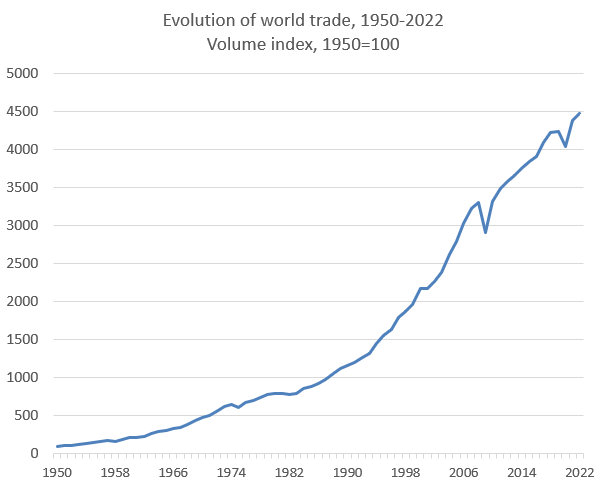Tags
Employment, government jobs, healthcare services, Jobs, jobs report, private sector jobs, public sector jobs, real private sector, subsidized private sector, {What's Left of) Our Economy
Last Thursday’s official U.S. jobs report was a big deal not only because the monthly payroll growth for January of 353,000 was nothing less than double most expectations. It also included the latest revisions, some of which once more highlighted a trend that RealityChek has long been following: the greatly shrunken role of industries that deserve to be called “private sector” (PS) as engines of employment growth, and the burgeoning role of government and what I’ve been calling the “subsidized private sector” (SPS).
This category features industries (especially health care services) officially classified as private sector, but that depend so heavily on government subsidies for growth and employment that this label simply doesn’t look deserved.
Moreover, the new jobs report shows that the importance of the SPS and the government proper surged especially powerfully last year. As I’ve noted repeatedly, this can’t be good news for anyone who believes (as everyone should) that durable American prosperity is best achieved by sectors of the economy dominated by market forces, rather than sectors dominated by politicians’ decisions.
One easy way to understand this change is to compare the national employment picture of 2022-23 with that of 2018-19 – the last full year before the CCP Virus wreaked havoc with both the economy itself and with the data it generated.
Back in 2019, the Labor Department reports that the private sector as the government has been defining it accounted for fully 89.19 percent (1.733 million) of that year’s total employment increase of 1.988 million. In addition, PS jobs conventionally defined represented 85.03 percent of the non-farm workforce (the Labor Department’s U.S. employment universe) on a stand-still basis. So these figures portray a national jobs market in which market forces are solidly in the driver’s seat.
But if the SPS is subtracted, the 2019 workforce in what might be called the real private sector (RPS) came to only 68.93 percent of all U.S. workers. That’s more than twenty percentage points less than the private sector conventionally defined. And that RPS’ growth was only 58.05 percent of the total workforce’ growth versus the 89.19 percent attributable to the conventionally defined private sector. Moreover, in 2019, the SPS expanded much faster (2.43 percent over 2018) than the conventionally defined PS (1.39 percent) or the entire workforce (1.33 percent).
At the same time, this disproportionate growth came even though the SPS in 2018 accounted for just 15.92 percent of the total workforce while the conventionally defined PS represented 84.97 percent and the RPS 64.81 percent. From another angle, despite its 15.92 percent share of the 2018 workforce on a static basis, the SPS generated 29.12 percent of the total 2018-2019 employment gain and 33.41 percent of the increase by the conventionally defined private sector.
Government employment in 2019, by contrast, underperformed. It represented 15.02 percent of the nation’s total 2018 workforce, but over the next year, its ranks rose by only 10.81 percent of all job gains.
Finally, when the government and the SPS are combined, they came to 30.94 percent of all U.S. Jobs in 2018. But between 2018 and 2019, they generated nearly 40 percent of the total employment increase.
In 2022, the official jobs figures show, the PS conventionally defined represented 85.50 percent of all U.S. Jobs – a level just slightly higher than that for 2018. Subtract the subsidized private sector, however, and this level drops to 69.45 percent – but this level is also scarcely changed from 2019’s.
Yet from 2022-23, the conventionally defined PS from 2022-23 spurred 77.49 percent of the nation’s overall employment growth. That number is significantly lower than that for 2018-19 – 89.19 percent. Yet when the SPS is subtracted, the growth contribution of the remaining real private sector sinks to just 42.87 percent – in other words, less than half of all the economy’s payroll increase, and much lower than that 58.05 percent figure of 2018-19. Meanwhile, the SPS itself is shown to have generated 34.62 percent of the economy’s total employment growth. And the overperformance was stunning, because the year before, the SPS came to just 16.06 percent in 2022 of total jobs on a standstill basis.
Accordingly, the absolute SPS’ increase from 2022-23 (4.27 percent) was much greater than that of the entire workforce (1.33 percent), of the real private sector (1.22 percent), and of the conventionally defined private sector (1.79 percent).
Moreover, government itself was the next fastest growing job category between 2022 and 2023, expanding at 3.08 percent.
The result was a total domination of 2022-23 job creation by government and government-dependent jobs – which together grew at a robust 3.70 percent (nearly three times faster than the total job creation rate of 1.33 percent), and accounted for fully 57.13 percent of the total expansion of payrolls last year. And the real private sector’s share was down to 42.87 percent – significantly lower than 2019’s 58.05%..
Interestingly, on a monthly basis, the latest official jobs report (which presents data that it still preliminary) shows something of a break in this pattern. Of the 353,000 new jobs the economy added from December to January, 317,000 (89.80 percent) were credited to the conventionally defined private sector.
The 112,000 jobs created by the SPS and the 36,000 created by government do represent 41.93 percent of total job creation for the month. But that still means that the real private sector share rebounded to 58.07 percent. One month hardly a trend makes, but so far these figures amount to another reason for viewing the January jobs report as a standout.

